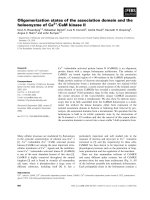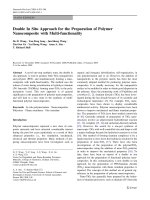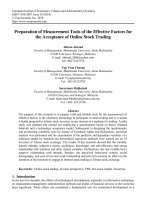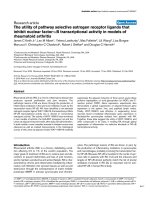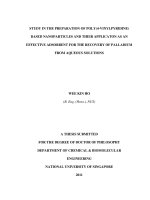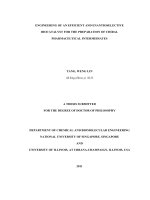The preparation of Ca2+–selective electrodes
Bạn đang xem bản rút gọn của tài liệu. Xem và tải ngay bản đầy đủ của tài liệu tại đây (289.59 KB, 4 trang )
<span class='text_page_counter'>(1)</span><div class='page_container' data-page=1>
<i>Can Tho University Journal of Science </i> <i>Vol. 11, No. 1 (2019): 60-63 </i>
60
<i>DOI: 10.22144/ctu.jen.2019.008 </i>
<b>The preparation of Ca</b>
<b>2+</b><b><sub>–selective electrodes </sub></b>
Nguyen Van Dat1*<sub>, Huynh Thanh Tuan</sub>1<sub> and Ronny Purwadi</sub>2
<i>1<sub>College of Natural Sciences, Can Tho University, Vietnam</sub></i>
<i>2<sub>Depertment of Chemical Engineering, Institut Teknologi Bandung, Indonesia </sub></i>
<i>*<sub>Correspondence: Nguyen Van Dat (email: ) </sub></i>
<b>Article info. </b> <b> ABSTRACT </b>
<i>Received 06 Jul 2018 </i>
<i>Revised 15 Sep 2018 </i>
<i>Accepted 29 Mar 2019 </i>
<i><b> Ion–selective electrode (ISE) is a useful tool in the direct determination of </b></i>
<i>ionic species in complex samples. This study relates to the manufacture of </i>
<i>Ca2+<sub>–selective electrode with single–barrelled microelectrodes and an </sub></i>
<i>in-ternal filling solution buffered for pCa (pCa= –lg[Ca2+<sub>]) of 6. It is shown </sub></i>
<i>that an improved lower detection limit of 10–6<sub> M is obtained in Ca</sub>2+<sub> buffer </sub></i>
<i>solution and the changes in electromotive force between two solutions of </i>
<i>10–fold change in Ca2+<sub> concentration are close to 30 mV/decade. </sub></i>
<i><b>Keywords </b></i>
<i><b>Cocktail A, EGTA, EMF, ISE, </b></i>
<i>microelectrodes, SICM </i>
Cited as: Dat, N.V., Tuan, H.T. and Purwadi, R., 2019. The preparation of Ca2+<sub>–selective electrodes. Can Tho </sub>
<i>University Journal of Science. 11(1): 60-63. </i>
<b>1 INTRODUCTION </b>
Ion–selective electrodes (ISEs) are electrochemical
sensors that allow the potentiometric determination
of the activity of an ionic species in the presence of
other kinds of ions. ISEs are cheap and simple
devices that can be miniaturized, allow on–line and
in–situ measurements. Ideally, they consume no
analyte during the measurement and usually do not
need sample preparation (Ceresa, 2001). Hence,
ISEs have been extensively studied over the past
four decades. They have been successfully applied
in many research fields, especially in routine clinical
analysis as well as in environmental and industry
<i>analyses (Lewenstam et al., 1991; Eriksen et al., </i>
2001).
ISEs have found widespread use for the direct
determination of ionic species in whole and diluted
blood, serum, urine, tissue, and intracellular
<i>samples. Eriksen et al. (2001) determined copper in </i>
natural water by the use of ISE. Similarly, the
determination of lead in drinking water by means of
<i>ISE has also been reported by Ceresa et al. (2001). </i>
<i>In another study, Miller et al. (2001) developed an </i>
ISE with internal solution for the direct
measurement of Na+<sub> in plant cells. In 2010, </sub>
<i>Hernandez et al. described determination of calcium </i>
ions in sap using carbon nanotube–based ion–
electrode. Recently, a new simple, highly specific
and calcium selective electrode has been prepared
by Vijayalakshmi and Selvi (2017). This calcium
selective electrode was also successfully used in the
analysis of concentration of Calcium ion in various
real samples (Vijayalakshmi and Selvi, 2017).
The present work is aimed to report on the
manufacture of Ca2+<sub>–selective electrode as a useful </sub>
analytical tool for many applications in practical.
<b>2 MATERIALS AND METHODS </b>
<b>2.1 Materials </b>
<i>N–(Trimethylsilyl)dimethylamine, ethylene glycol–</i>
</div>
<span class='text_page_counter'>(2)</span><div class='page_container' data-page=2>
<i>Can Tho University Journal of Science </i> <i>Vol. 11, No. 1 (2019): 60-63 </i>
61
acetone, and cocktail A (0.1 mL) were obtained
from Fluka.
<b>2.2 Methods </b>
<i>2.2.1 Manufacturing Ca2+<sub>–selective electrode </sub></i>
The capillaries were pulled from borosilicate glass
with filament (O.D = 1mm; I.D = 0.5 mm; length =
10 cm; item # BF 100–50–10) with PP–830 single
stage glass microelectrode puller at Biochemistry
Lab, Chungnam National University, Korea. Then,
the capillaries were placed in a petri dish and backed
at least 3 hours at 150°C to remove trace of water.
Next, <i>N-(trimethylsilyl)–dimethylamine </i> was
injected into the tip of capillary. The reagent was
allowed to react in the vapor phase for 12 hours at
<i>200°C (Ammann et al., 1987). After silanization, </i>
they were broken to the desired tip size and filled
with calcium buffer solution.
<b>Fig. 1: Construction of Ca2+<sub>–selective electrode </sub></b>
Using Scanning Electro Microscope Olympus SZ51
at Electrochemistry Lab, Chungnam National
University, Korea, a short column of the Ca2+<sub>–</sub>
selective sensor was introduced into the tip by
capillarity, or suction if necessary. Also, in order to
prevent the tip from breaking (the tip of capillary is
very fine), the tip of capillary was immersed into the
solution consisting of 1 mL of 10% (wt./vol) bovine
serum albumin in 50 mmol Na3PO4 and 10 L of
25% glutaraldehyde, and solution of 10% cellulose
acetate in acetone, respectively. Finally, the Ca2+<sub>–</sub>
selective electrode was completed by insertion of a
chlorinated silver wire which was fixed at the end of
the original capillary tubing by using drops of wax.
Ion–selective liquid membranes are organic
cocktails and hydrophobic. Freshly, pulled
electrodes are, in comparison, hydrophilic. Due to
the density of surface hydroxyl groups, (4.6 free OH
groups per 10 nm2<sub>) charged surfaces produce a </sub>
monomolecular hydrophobic allowing the organic
liquid membrane to bed comfortably in the tip of the
electrode, no longer being displaced by the
electrolyte. The pipette was mounted on a
micromanipulator and immersed into the membrane
solution (cocktail A). Cocktail A will easily
penetrate into the tip of pipette owing to capillary
force (liquid membranes are organic cocktails and
hydrophobic). Besides, tip becomes hydrophobic
after silanization. The time to obtain required
cocktail column length depends on the tip diameter
<b>and efficiencies of the silanization. </b>
<i>2.2.2 Making reference electrode </i>
Firstly, a chlorinated silver wire was prepared by
soaking silver wire in a solution of HNO3<i> ca. one </i>
hour followed by cleaning with distilled water. It
was then soaked in a HCl solution about ten minutes
and cleaned by water again. Secondly, reference
electrode was prepared from micropipette filled
with 3 M KCl solution. Finally, reference electrode
was completed by insertion of a chlorinated silver
wire which was fixed at the end of the original
capillary tubing by a drop of wax.
<i>2.2.3 Preparing for internal solution </i>
In the region of pCa = 2–4, it was found that the
solution prepared very carefully by normal dilution
<i>techniques was satisfactory (Ammann et al., 1987). </i>
At low concentration, Ca2+ <sub>will be lost by adsorption </sub>
on glass or reaction with impurities. An alternative
is to prepare a metal ion buffer from the metal (Ca2+<sub>) </sub>
and a suitable ligand (EGTA) (Tsien and Rink,
1981). Also, a buffer solutions with a constant pH
<i>of 7.40 used in this work (Ammann et al., 1987). </i>
The preparation for the buffer solution has been
<i>describe in the literature (Ruzica et al., 1973). </i>
<b>Table 2: The composition of buffer solution </b>
<b>Mass, g </b> <b><sub>pH</sub>a</b> <b><sub>Volume of solution, mL </sub></b>
<b>CaCl2.2H2O </b> <b>EGTA </b>
pCa = 6 0.0694 0.1902 7.4 50
pCa = 7 0.0462 0.1902 7.4 50
`pCa = 8 0.0107 0.1902 7.4 50
</div>
<span class='text_page_counter'>(3)</span><div class='page_container' data-page=3>
<i>Can Tho University Journal of Science </i> <i>Vol. 11, No. 1 (2019): 60-63 </i>
62
<i>2.2.4 Making a measurement </i>
In order to measure in electromotive force (EMF),
the following electrochemical cell is constituted:
Ag│AgCl│KCl║bridge
electrolyte║sample║membrane║inner filling
solution│AgCl│Ag
All potential measurements were made using a
digital pH meter benchtop–Orion 3 Star at
Electrochemistry Lab, Chungnam National
University, Korea. In order to evaluate influences of
internal filling solution on Ca2+<sub>–selective electrode, </sub>
a set of five different ISEs were prepared. They
consisted of 10–2<sub> M Ca</sub>2+<sub> (ISE–2), 10</sub>–3<sub> M Ca</sub>2+ <sub>(ISE–</sub>
3), 10–4<sub> M Ca</sub>2+ <sub>(ISE–4), 10</sub>–5<sub> M Ca</sub>2+<sub> (ISE–5), and </sub>
10–6<sub> M Ca</sub>2+<sub> (ISE–6). All calibration curves were </sub>
measured from the higher (10–1<sub> M Ca</sub>2+<sub>) to the lower </sub>
concentrated (10–10<sub> M Ca</sub>2+<sub>).</sub>
<b>Fig. 2: Scheme of EMF measurement</b>
<b>3 RESULTS AND DISCUSSION </b>
<b>3.1 Influences of internal filling solution </b>
The EMF is the difference between the potentials of
two electrodes immersed into a solution. A pair of
electrodes immersed into a solution makes the so–
called galvanic cell. One of the electrodes (the so–
called indicator electrode) in the galvanic cell obeys
the Nernst equation, while the potential of the other
electrode (reference electrode) is constant. Figure 3
demonstrates that the EMF of ISE–2, ISE–4 and
ISE–5 are strongly affected by the change in Ca2+
concentration in the range of 10–7<sub>–10</sub>–6<sub> M. In the </sub>
range of 10–10<sub>–10</sub>–7<sub> M, it can be observed that the </sub>
EMF is independent of Ca2+<sub> concentration. </sub>
<b>Fig. 3: Response of five ISEs with identical but different </b>
<b>in internal filling solutions: ISE–2 (lg[Ca2+<sub>] = 10</sub>–2<sub> M), </sub></b>
<b>ISE–3 (lg[Ca2+<sub>] = 10</sub>–3<sub> M), ISE–4 (lg[Ca</sub>2+<sub>] = 10</sub>–4<sub> M), </sub></b>
<b>ISE–5 (lg[Ca2+<sub>] = 10</sub>–5<sub> M), ISE–6 (lg[Ca</sub>2+<sub>] = 10</sub>–6<sub> M) </sub></b>
<b>Fig. 4: Detection limit of Ca2+<sub>– selective </sub></b>
<b>electrode, conditioned in: the Ca2+</b>
<b>concentration in internal filling solution of </b>
</div>
<span class='text_page_counter'>(4)</span><div class='page_container' data-page=4>
<i>Can Tho University Journal of Science </i> <i>Vol. 11, No. 1 (2019): 60-63 </i>
63
For any ISEs in present study, a rather good lower
detection limit of around 10–6<sub> M is obtained and the </sub>
slope of the plot was found to be 30 mV/decade.
<b>However, the concentration of free calcium is very </b>
low to eliminate small flux of primary ion (Ca2+<sub>) </sub>
from internal filling solution into calibration
solu-tion (or sample solusolu-tion). If small flux of primary
ion enters the sample solution, EMF value is not
sta-ble this means that the voltage of the cell will drift
with time. Therefore, ISE–6 is the best choice since
Ca2+<sub> concentration is the lowest among ISEs made. </sub>
<b>3.2 Ca2+<sub>–electrode characterization </sub></b>
Plotting the steady–state potentials obtained from
<i>measurements versus the logarithm of the ion </i>
con-centration revealed a typical ion–selective electrode
response (Figure 3). The linear working range was
determined to be –6 < lg[Ca2+<sub>] < –1, which </sub>
approx-imately corresponds to a range of Ca2+<sub> concentration </sub>
from 10–6 <sub>M to 10</sub>–1<sub> M. While the detection limit was </sub>
estimated to be lg[Ca2+<sub>] = –6 (i.e. [Ca</sub>2+<sub>] = 10</sub>–6 <sub>M), </sub>
the slope of the curve in the linear range (i.e. the
sensitivity of the Ca2+<sub>–selective electrode) was </sub>
de-termined to be 30 mV/decade, which is in complete
accordance with the Nernst equation for positively–
charged divalent ions.
<b>4 CONCLUSIONS </b>
These findings make it clear that the developed
elec-trodes showed response time of 10 seconds. A
dy-namic linear range of 1×10–6<sub>–1×10</sub>–1<sub> mol L</sub>–1<sub>, </sub>
Nern-stian slope of 28.57 mV decade–1<sub> and detection limit </sub>
of 10–6<sub> mol L</sub>–1<sub> were obtained for the electrode. It is </sub>
too early to claim that Ca2+<sub>–selective electrode </sub>
made demonstrated the potential as a promising
candidate because its applications requires further
study, however, a detailed procedure for making a
Ca2+<sub>–selective electrode was presented in this work. </sub>
<b>ACKNOWLEDGMENTS </b>
This study was supported by The Korea Research
Institute of Standards and Science (KRISS), Korea;
Department of Chemistry–Chungnam National
Uni-versity (CNU), Korea; Korea Advanced Institute of
Science and Technology (KAIST); Department of
Chemistry–Pusan National University (PNU),
Ko-rea.
<b>REFERENCES </b>
Ammann, D., Bührer, T., Schefer, U., Müller, M., and
Si-mon, W., 1987. Intracellular neutral carrier–based
Ca2+ microelectrode with subnanomolar detection
limit. European Journal of Physiology. 409: 223–228.
Ceresa, A., Bakker, E., Hattendorf, B., Gunther, D., and
Pretsch, E., 2001. Potentiometrie Polymeric
Mem-brane Electrodes for Measurements of
Environmen-tal Samples at Trace Levels: New Requirements for
Selectivities and Measuring Protocols, and
Compari-son with ICPMS. Anal. Chem. 73: 343–351.
Ceresa, A., 2001. Ion–Selective Polymeric Membrane
Electrodes for Potentiometric Trace Level
Measure-ments. A dissertation for the degree of Doctor of
Natural Sciences. Swiss Federal Institute of
Technol-ogy (ETH Zürich).
Eriksen, R.S., Mackey, D.J., van Dam, R., and Nowak,
B., 2001. Copper speciation and toxicity in
Mac-quarie Harbour, Tasmania: an investigation using a
copper ion selective electrode. Mar Chem. 74(2–3):
99–113.
Hernandez, R., Riu, J., and Rius, F.X., 2010.
Determina-tion of calcium ion in sap using carbon nanotube –
based ion – selective electrodes. Analyst. 135(8):
1979–1985.
Lewenstam, A., Maj–Zurawska, M., and Hulanicki, A.,
1991. Electroanalysis. Application of ion-selective
electrodes in clinical analysis. Electroanalysis. 3(8),
727–734.
Miller, A.J., Cookson, S.J., Smith, S.J. and Wells, D.M.,
2001. The use of microelectrodes to investigate
com-partmentation and the transport of metabolized
inor-ganic ions in plants. Journal of Experimental Botany.
52(356): 541–549.
Ruzica J., Hansen E.H., Tjell, J.C., 1973. Selectrode – the
universal ion–selective electrode. Part IV. The
cal-cium (II) selectrode employing a new ion exchanger
in a nonporous membrane and solid–state reference
system. Anal Chim Aceta 67(1): 155 – 178.
Tsien, R. Y., and Rink, T. J., 1981. Ca2+-selective
elec-trodes: a novel PVC-gelled neutral carrier mixture
com-pared with other currently available sensors. Journal of
neuroscience methods, 4(1): 73-86.
</div>
<!--links-->


